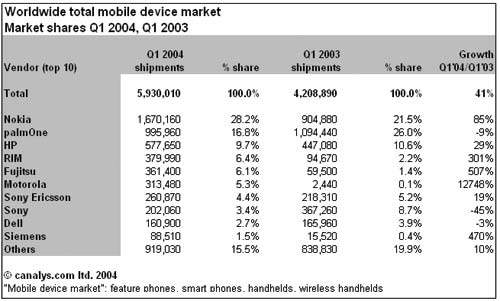Smartphone Market Recap

Palm Info Center has the results of the Canalys worldwide smartphone results for Q1. This has been big news this morning on just about every mobile news site there is. What I find most interesting is that this is the first time I've seen that Canalys has combined the mobile device numbers. I remember when I reported on the same sort of chart from last year and it was obvious that smart phones were outselling PDAs by large margin, but the numbers were on two different charts.
First, not to continue beating on poor Palm, but you can see by the numbers that Nokia is wooping PalmOne's ass. PalmOne's numbers include everything from the $79 Zires to their Treos and Nokia is still outselling them by almost double - and the cheapest Nokia smart phone costs at least $300. It's clear as day, even though the PDA market is increasing in real numbers, the percentages of mobile devices are dwindling fast (follow the link above for more on those numbers). Combine this with Sony's announcement today that they are suspending new development of Clies here in the U.S. (the other big news of the day) and you can see the writing on the wall.
Sony's news is definitely interesting as I've been betting on Sony buying PalmSource. Why? Well first, I read that Sony is interested, but secondly Sony is one of the only major device manufacturers without control over their own OS. I can't imagine that Sony likes paying Symbian for their OS on the P900s or PalmOS for their Clies. Now I wonder if this will still happen. Pulling Clies out of the market where Palms sell the best? Not a good sign. I'm sure it's another example where Sony has decided not to bet on a dwindling market - the same as the announcement not too long ago that they aren't going to be developing any more low-end digital cameras, instead ceding that market to mobile camera phones. Clies still will be developed in Japan where I guess they are still very popular, but I really wonder what Sony's long-term plan is for their device OS. PalmOS, Symbian, Linux, TRON? Something else? Not having their own means a clear risk of becoming a Dell-like commodity manufacturer. They must realize this.
Back to the chart above. I will say that I thought Nokia was selling a lot more phones. 1.6 million smart phones in 3 months isn't as nearly as high as I thought it would be. It's nothing to sneeze at, but in order for Symbian and Series 60 to become a mass market OS, those numbers need to increase exponentially. Nokia announced that they are shipping the 7610 as of today everywhere besides the U.S. (why?!?) but with a price around $699 - that's not going to help this situation.
There's two things I'm just outright ignoring in the report: regional discrepencies insales and Research In Motion. I think that as time goes by - even as quickly as the next year, we're going to see sales even out throughout the world. Basically, it'll be Symbian and then everyone else. Secondly, I have no idea what to make from Research In Motion. Their devices are still so proprietary and bulky... I just see them as a continuing niche player. That doesn't mean they'll disappear like Palm, they've got continuing revenues from any manufacturer who's device allows you to check email wirelessly, but in terms of actual devices I don't see the becoming anything but more segmented as time goes by.
Here's my thoughts on what's going to happen in the next 6 months. Ready? We're going to see Motorola go up the ranks considerably and we're going to see Samsung appear out of the "other" category. Why? Because both companies have licensed the various OSes and are going to be targeting Nokia's lead in the market with everything they've got. Windows Mobile 2003 does not suck, Moto's phones are not bad, and Samsung can crank them out. As competition increases in the smart phone market, all these numbers on the chart above are going to be continually in flux over the next year, and it should be very interesting to watch.
That said, the *next* chart I'd like to see is these numbers compared with Java-enabled multimedia capabile mobiles as well, just to see the discrepency in sales between what's happening at the "high-end" and what's happening with the mass-market. If this chart includes devices as low-powered as the Zires, then it seems ridiculous that more-than capable phones with PIM and messaging functionality like the Nokia 6800 aren't included as well.
I mean, really, that chart above is tracking 5 million of the 600+ million devices that are going to be sold this year. It's interesting, but its not anywhere near in perspective as it could be.
-Russ